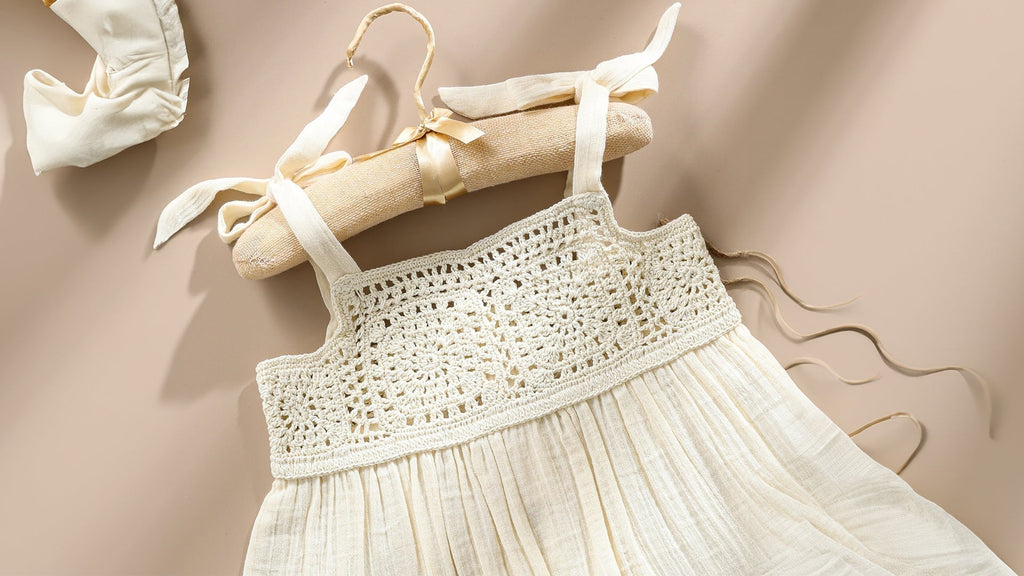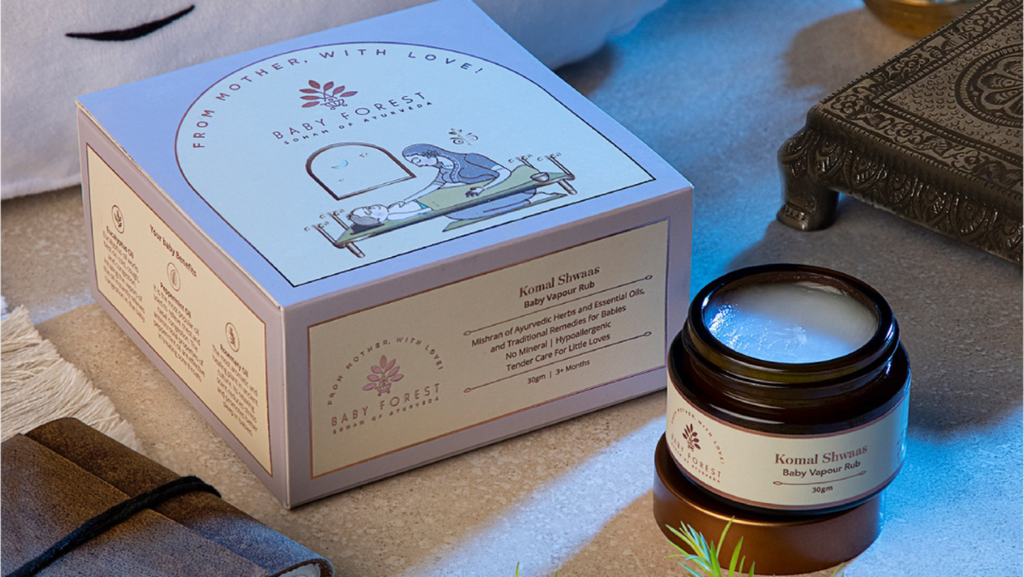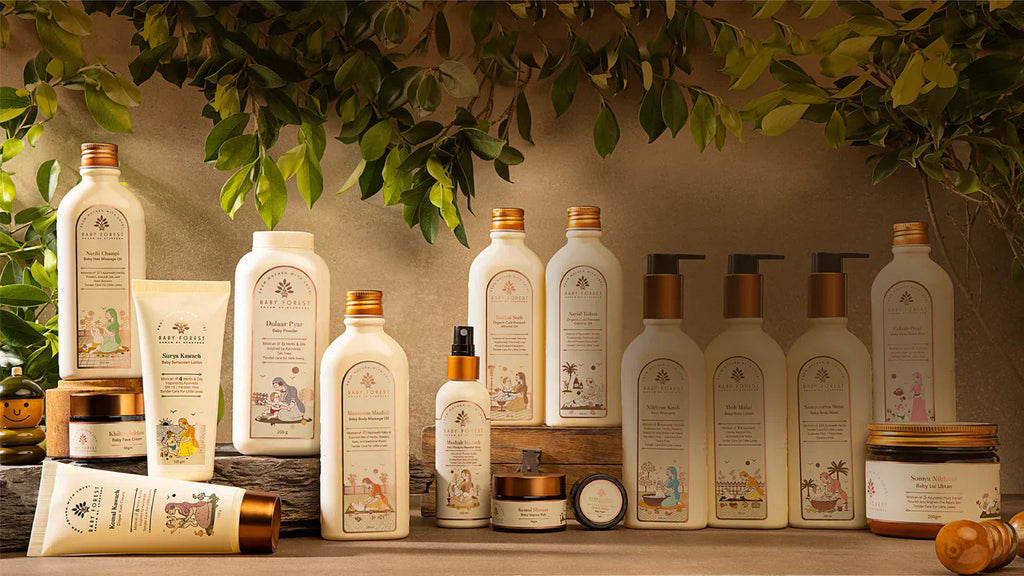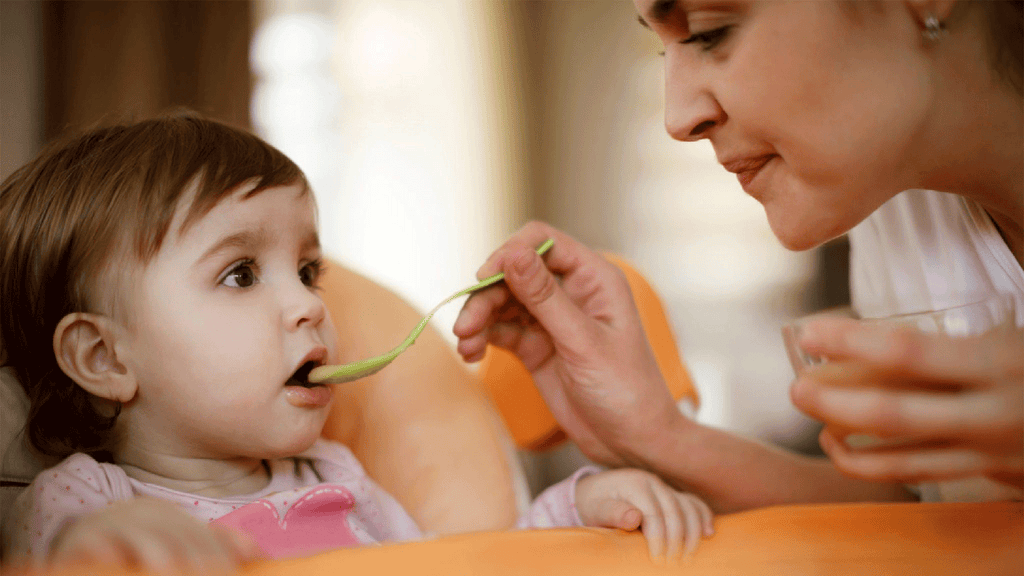Baby Care & Parenting Blogs

A Parent's Guide to Organic Baby Clothes: What You Need t...
In recent years, there has been a significant shift towards organic and eco-friendly products, with a special focus on the needs of the youngest members of our families. As parents, we aspire to provide the best for our little ones, from the food they eat to the baby clothes they wear. In recent years, the spotlight has turned towards organic baby clothes, a choice that promises comfort and style and a commitment to health and environmental stewardship. This guide is designed to walk you through everything you need about organic baby clothes, helping you make informed decisions for your family and our planet.
Understanding Organic Newborn Clothes
Organic baby clothes are crafted from fabrics that are cultivated and processed without employing harmful pesticides, artificial fertilizers, or genetically modified organisms (GMOs). The most common fabric you'll encounter is organic cotton, prized for its softness, durability, and breathability. Unlike conventional cotton, organic cotton farming emphasizes ecological balance and biodiversity, ensuring that the fabric touching your baby's skin is as pure and natural as possible.
Why Is Organic Cotton Better for Babies?
In the vast world of baby products, choosing the right fabrics for your little one's clothing, bedding, and toys is more crucial than one might think. Among the myriad options available, organic cotton stands out as a beacon of safety, comfort, and sustainability. Here's why organic cotton is a superior choice for your baby's needs.
Gentle on Delicate Skin
Infants have exceptionally delicate skin, which is more susceptible and easily irritated compared to the skin of adults. Organic cotton, cultivated without the introduction of severe chemicals, pesticides, or artificial fertilizers, presents a clean and mild option. It reduces the risk of allergic reactions, rashes, and skin irritations that can be triggered by non-organic cotton and its chemical residues. This natural fabric ensures that only the softest, most natural material touches your baby's skin.
Superior Comfort and Breathability
The comfort of organic cotton is unparalleled, thanks to its softness and excellent breathability. It helps regulate body temperature, keeping babies warm in winter and cool in summer. This natural fabric absorbs moisture and allows air to circulate, preventing overheating and ensuring your baby stays comfortable, whether asleep or awake. The durability of organic cotton also means it can withstand frequent washing, maintaining its softness and comfort over time.
How to Choose Baby Clothes Online?
Opting for organic baby clothes is a choice that blends health, style, and comfort in the wardrobe of the littlest ones in our lives. By selecting garments made from 100% organic materials, parents ensure that their babies are dressed in the purest, chemical-free fabrics that safeguard their delicate skin from irritants and allergens. Also, consider the functionality of the clothing; easy-to-use snaps, room for growth, and comfort should be at the top of your mind.
Caring for Organic Baby Clothes:
To maintain the integrity of the fabric, it's recommended to wash organic baby clothes in gentle, eco-friendly baby detergents. Avoid using bleach and opt for natural stain removers. Air drying is preferable to preserve the fabric's natural softness and prolong the garment's life.

Transitioning to organic baby clothes doesn't have to be an all-or-nothing approach. Start by replacing items that are in direct contact with your baby's skin, such as bodysuits, sleepwear, and bedding. As you become more acquainted with organic brands and products, you can gradually expand your baby's wardrobe. Remember, every small step towards organic contributes to a larger impact on your baby's health and the environment.
Choosing organic baby clothes is more than a shopping decision; it's a heartfelt commitment to the well-being of your precious child, the preservation of our environment, and the legacy we leave for the generations to come.
In today's world, where the market is brimming with organic options, making this choice has become both simple and convenient. It's an opportunity to live a lifestyle that reflects our deepest values, prioritizing the health of our children and the sustainability of the planet they will call home.

Nourishing the New Mother: Ayurvedic Postnatal Care Pract...
The postpartum period is a transformative and delicate time for a new mother. It's a phase that demands care, nurturing, and attention to ensure the well-being of both the mother and her newborn. Ayurveda, the ancient Indian medical system, takes a holistic approach to postnatal care, emphasizing the balance of body, mind, and spirit. This article explores Ayurvedic practices for postpartum care, offering new parents insights into after-delivery care for the mother through time-tested wisdom.
Ayurvedic Principles of Postpartum Care
Ayurveda views the postpartum period as a critical time for healing and rejuvenation. It emphasizes warmth, rest, and nourishment to restore the balance and energy lost during delivery. The Ayurvedic approach to postnatal care focuses on simple, natural practices and remedies to support the mother's recovery and enhance her ability to care for her newborn.
Ayurvedic Nutrition for Postpartum Wellness
Sattvic Foods for Healing:
Ayurveda recommends a sattvic diet to promote purity and balance in the body. Foods like rice, lentils, fruits, and vegetables that are easily digestible support the body's healing process and aid in milk production.
Herbal Infusions and Teas:
Herbal teas made from fenugreek, fennel, and ginger are valued in Ayurveda for their digestive and lactation-supporting properties. These gentle infusions help soothe the digestive system and enhance milk supply.
The Importance of Ghee:
Ghee, or clarified butter, is considered highly nourishing and rejuvenating in Ayurveda. Incorporating ghee into the diet helps improve digestion, promote healing, and provide vital energy post-delivery.
Self-Care Practices
Ayurvedic Abhyanga (Oil Massage):
Regular self-massage with warm oil, known as Abhyanga, can significantly aid in postpartum recovery. It helps relieve stress, improve circulation, and strengthen the body. Sesame oil is often recommended for its warming and nourishing properties.
Herbal Baths and Steams:
Herbal baths and vaginal steams with healing herbs like lavender, chamomile, and calendula can be soothing and promote healing, especially after a cesarean delivery or vaginal birth.
Restorative Rest:
Rest is a cornerstone of Ayurvedic postpartum care. It is essential for the new mother to get adequate sleep and relaxation to replenish her energy and support her body's healing process.
Emotional Well-being
Mindful Practices for Emotional Balance:
Practices such as meditation, yoga Nidra, and gentle pranayama (breathing exercises) can help new mothers manage stress, combat postpartum depression, and maintain emotional equilibrium.
Connecting with the Newborn:
Ayurveda emphasizes the deep bond between the mother and her baby. Skin-to-skin contact, breastfeeding, and spending quality time connecting with the newborn are considered vital for the emotional well-being of both the mother and the child.
Gradual Physical Activity
Introduction to Postpartum Exercise in Ayurveda:
Ayurveda advocates for a gradual return to physical activity. Gentle yoga and walking are recommended to strengthen the body, improve flexibility, and promote overall well-being. These activities should only be started once the mother feels ready and with the approval of her healthcare provider.
The postpartum period is a time of profound change and adjustment. Ayurvedic postnatal care practices offer a compassionate and nourishing approach to support the new mother's journey towards recovery and bonding with her baby. By incorporating principles of Ayurvedic nutrition, self-care, and gradual physical activity, new mothers can experience a holistic recovery, setting a strong foundation for their new role. Embracing these ancient practices can lead to a balanced, joyful, and healthy postpartum period, enriching the experience of motherhood in the most natural and supportive way.

A Beginner's Guide to Baby-Led Weaning
The goal of baby-led weaning (BLW) is to foster self-feeding in infants by gradually introducing solid foods. As your little one approaches that significant six-month milestone, it's only natural to find yourself immersed in a sea of information, exploring the myriad ways to commence this new chapter of their development.
In this beginner's guide, we'll explore what baby-led weaning means, when to start, choosing the right first foods, safe feeding practices, encouraging self-feeding skills, and more.
What is Baby-Led Weaning?
Baby-led weaning is a method of introducing solid foods to infants so they can feed themselves. Unlike traditional spoon-feeding, where parents decide what and how much a baby eats, BLW allows the baby to explore and self-feed from the very beginning.
The essence of this method lies in offering age-appropriate, whole foods in a form that babies can easily grasp and feed themselves. Typically, baby-led weaning begins around the age of six months when babies show signs of readiness, such as sitting up unassisted and displaying an interest in reaching for food.
In a baby-led weaning approach, purees, and spoon-feeding take a backseat, and the focus shifts to allowing the baby to explore various textures, tastes, and sizes of food. The goal is not just to introduce solids but to encourage independence, promote self-regulation of appetite, and develop essential fine motor skills.
As babies experiment with different foods, they learn to chew, swallow, and, importantly, listen to their own hunger cues. The process emphasizes a more inclusive and shared dining experience, fostering positive associations with food from an early age.
When to Start Baby-Led Weaning?
The optimal time to start baby-led weaning is when your baby shows signs of readiness, which is often about six months old. At this point, babies can sit up unassisted, have developed good neck control, and are showing an interest in reaching for food. Always with your pediatrician before beginning any new feeding methods.
What is the Right First Foods for Baby-Led Weaning?
Baby-led weaning is an exciting adventure for your little one's taste buds. When introducing the first foods, opt for soft, easy-to-grip options. Foods like steamed vegetables, ripe fruits, and well-cooked grains are excellent choices. Remember, the emphasis is on offering a variety of nutrient-dense foods that are appropriate for your baby's age.
Safe Feeding Practices for Infants:
Ensuring a safe feeding environment is vital during baby-led weaning. Always stay close to your baby while they are eating, and never leave them unattended. To further enhance safety and sustainability, consider using bamboo feeding plates or bamboo feeding bowls. These eco-friendly alternatives are lightweight, durable, and free from harmful chemicals often found in plastic.

When it comes to food preparation, cut foods into age-appropriate sizes to minimize the risk of choking. Be mindful of potential allergens and introduce one new food at a time, waiting a few days before introducing another. Incorporating these safe and eco-conscious practices not only prioritizes your baby's well-being but also contributes to a healthier planet for their future.
Encouraging Self-Feeding Skills:
One of the main principles of baby-led weaning is encouraging self-feeding, turning mealtime into an interactive and joyful experience for your little one. As your baby explores different textures, tastes, and sizes of food, consider adding a playful touch with bamboo feeding plates. Crafted in various shapes, these eco-friendly bamboo plates for infants can make the dining experience more engaging and exciting for your baby.
Resist the urge to intervene too quickly; allow them to develop hand-eye coordination and chewing skills independently. This not only fosters a sense of autonomy but also helps in refining their fine motor skills. By incorporating bamboo plates with different shapes, like owl-shaped plates or car-shaped plates, you not only prioritize safety and sustainability but also add an element of fun to your baby's culinary adventure.

Dealing with Mess and Cleanup:
Mess is an integral part of the baby-led weaning experience, and it's essential to embrace it. Use a high chair with a removable tray for easy cleaning, place a bib on your little one, and perhaps invest in a splat mat to catch stray crumbs. It's always a good idea to keep wet wipes or a damp cloth within reach for easy cleanups. The mess is temporary, but the skills your baby is developing are long-lasting. Unlike conventional plastic and metal plates, bamboo feeding plates don't retain bacteria or odors from your baby's meal. Featuring a silicon suction base, the feeding plate effortlessly adheres to any flat surface, ensuring a spill-free mealtime and keeping your little one both engaged and focused on their delicious meal.
Parents often have concerns about whether their baby is getting enough nutrition or whether they will choke. It's crucial to remember that baby-led weaning is a gradual process, and each baby progresses at their own pace. Offering a variety of foods ensures a balance of nutrients.
If you have concerns, consult with your pediatrician. Additionally, consider joining supportive communities or forums where parents share their baby-led weaning experiences and tips.
Baby-led weaning is an exciting and rewarding journey that allows your baby to explore the world of food in a way that is both enjoyable and beneficial. By introducing this method, you're not only nourishing your baby's body but also fostering a positive relationship with food from an early age.
Embrace the mess, celebrate the milestones, and enjoy watching your little one embark on this flavorful adventure of self-discovery. Remember, baby-led weaning is not just about what your baby eats but about instilling a lifelong love for healthy and varied foods. Happy feeding!

07 Winter Tips for Your Baby's Delicate Skin
As winter blankets the world in a chilly embrace, parents face the challenge of safeguarding their little ones from the harsh effects of the season. Your baby's delicate skin requires extra care during the colder months to combat issues like dryness and irritation. In this guide, we'll explore seven essential tips for maintaining your baby's skin health during winter.
Choose Gentle Cleansers
The first step in crafting a winter skincare routine for your baby is selecting gentle cleansers. Opt for soap-free and fragrance-free baby body washes that are specifically formulated for delicate skin. Harsh chemicals can deplete the skin's natural oils, causing dryness and irritation. The gentle formula of the Sampoorna Snan Baby Body Wash is enhanced with the nourishing and calming properties of ten Ayurvedic herbs and oils. Regular use of a mild baby body wash will help maintain your baby's skin's pH balance and prevent winter-related skin issues.

Hydrate with Baby-Friendly Moisturizers
Moisturising is a crucial aspect of winter baby skin care, especially for newborns and infants with sensitive skin. Invest in baby body lotion that is free from harsh chemicals, fragrances, and dyes. You can opt for baby skincare products containing natural ingredients like shea butter, mulethi, and rose petals, known for their moisturising and nourishing properties. Applying a gentle baby body lotion regularly helps create a protective barrier, preventing your baby's skin from losing essential moisture in the dry winter air.

Choosing Winter Appropriate Skincare
Winter demands a shift in your baby's skincare routine to address specific challenges. Consider using thicker creams or baby oils during this season, as they provide a more effective barrier against harsh weather conditions. Products with added vitamins like A and E can further enhance skin protection and promote overall skin health. Remember that consistency is crucial, so continue your baby's skincare regimen on a daily basis to keep their skin supple and hydrated over the winter.

Dress in Layers for Outdoor Protection
When venturing outdoors, dressing your baby in layers is a practical approach to ensure warmth and protection. Use soft, breathable fabrics like cotton as the base layer, and add warmer layers as needed. Ensure that your baby's extremities are well-covered with mittens and booties to prevent exposure to cold winds. Additionally, don't forget a cosy hat to retain body heat. Layering not only safeguards your baby from the cold but also allows for easy adjustment as temperatures fluctuate. You can also use a pashmina baby blanket for your baby to be comfortable in the cold weather.

Maintain a Comfortable Indoor Environment
Making your home cosy throughout the winter months is essential for the health of your baby's skin. Use a humidifier to combat the dry indoor air caused by heating systems. This keeps the humidity at just the right amount and keeps the skin of your infant from drying out too much. Regularly moisturise your baby's hands and face, as these areas are more prone to dryness. Striking a balance between warmth and humidity is essential for ensuring your baby's skin remains soft and healthy.
Limit Bath Time
Baths are a nice way to stay warm in the winter, but continuous use of hot water can cause dryness by robbing the skin of its natural oils. Limit bath time to around 5-10 minutes and opt for lukewarm water instead of hot water. Use mild, fragrance-free baby soap sparingly to avoid over-cleansing. After washing your infant, pat dry with a soft towel and use a mild moisturiser to help lock in moisture.

Choose Soft and Breathable Fabrics
The choice of clothing can significantly impact your baby's skin health. During winter, opt for soft, breathable fabrics like cotton to minimise skin irritation. To prevent skin irritation, it is recommended to avoid wearing clothes that rub against your skin. Dress your baby in loose layers to trap heat without causing overheating. Check for indicators of irritation or redness on a regular basis and modify your apparel accordingly. A comfortable wardrobe contributes to happy and healthy winter skin for your little one.
Be Mindful of Laundry Products
The fabrics that come into direct contact with your baby's skin include clothing, bedding, and blankets. Choosing the right baby laundry products is crucial to avoid potential irritants. Opt for hypoallergenic, fragrance-free baby detergents to wash your baby's clothes and bedding. Rinse thoroughly to remove any detergent residue that could cause irritation. Soft, clean fabrics against your baby's skin play a significant role in preventing dryness and discomfort during the winter months.

Your baby's delicate skin deserves extra attention during the winter season. Following these seven winter tips, focusing on baby skincare for winter will help create a protective shield against the harsh elements. Remember, consistency is key, and by incorporating these tips into your baby's daily routine, you can ensure that their skin stays soft, moisturised, and healthy throughout the winter months.

How to Prepare for Baby's First Cold and Flu Season: A Co...
While you enjoy the joy of your newborn's arrival, it's critical that you arm yourself with knowledge and methods for managing the upcoming cold and flu season. This comprehensive guide is crafted to empower you with essential information, ensuring that you can confidently protect your little one during their first encounter with seasonal sniffles and sneezes.
A baby's first cold can be concerning for parents, but with gentle care, plenty of rest, and monitoring of their symptoms, most infants recover well and build resilience to future illnesses.
Signs and Symptoms:
Keep an eye out for changes in your baby's health, starting with their breathing. If you notice persistent coughing, difficulty breathing, or a stuffy nose, consider using a gentle saline solution to help them breathe better. Be attentive to any changes in behaviour, such as increased fussiness or alterations in their sleeping habits. If your baby becomes less active or has trouble feeding, it's time to consult with your paediatrician for guidance.
Feeding difficulties, like refusing to eat or changes in sucking patterns, may also be signs of discomfort during a newborn cold. If your baby gets a fever or appears cold, use a reliable thermometer to check their temperature and follow your paediatrician's fever management instructions. Keep an eye on your baby's tummy, too vomiting or diarrhoea may require special attention, and it's essential to keep them hydrated with small, frequent feeds. You can also use a vapour rub for babies to help them clear the breathing pathway and treat sore throat.
Remember, you know your baby best, and if you ever feel uncertain or notice persistent signs of discomfort, don't hesitate to reach out to your paediatrician during your baby’s first cold.
Understanding the Risks:
-
Vaccinations
Making sure your baby stays healthy is super important, and one great way to do that is by getting them vaccinated. Speak to your baby's doctor to create a plan that's just right for them, making sure they get all the shots they need. These shots help their body become strong and protect them from getting sick. It's like giving them a superhero shield against germs! So, working together with the doctor to give your baby these shots are a fantastic way to keep them safe and sound. -
Maintain Good Hygiene:
Taking good care of your newborn involves being a hygiene hero! Make sure to wash your hands regularly and ask anyone who visits to do the same. This helps keep germs away. Keep your baby's essentials, like toys and pacifiers, super clean by washing and sanitising them. Being extra careful about cleanliness creates a safe and healthy space for your little one. So, remember to be a hygiene superhero to protect your baby's health!
Creating a Healthy Environment:
-
Clean and Disinfect:
A clean-living space is fundamental to your baby's well-being. Clean and sanitise regularly touched surfaces such as changing tables and cot rails on a regular basis. Use baby detergent to clean your baby's clothes. Our Swaksh Khilone Baby Toy & Surface Cleaner is an Ayurvedic remedy for keeping your child's toys and surfaces clean and safe. This one-of-a-kind cleaner is made with Ayurvedic components to provide the best care for your child. Choose baby-safe disinfectants to maintain a germ-free zone without exposing your little one to harmful chemicals. -
Humidifier Use:
Investing in a quality humidifier can make a significant difference. Maintaining optimal humidity levels in your baby's room helps alleviate congestion and keeps airways moist, reducing the likelihood of respiratory issues. Regular cleaning of the humidifier prevents mould and bacteria buildup.
Monitoring Your Baby's Health:
-
Know the Signs of Illness:
Learn about common signs of illness in newborns, like persistent coughing, increased fussiness, or changes in feeding habits. Spotting these early on helps you take action promptly and prevent minor issues from getting worse. -
Regular Check-ups:
Scheduled check-ups with your paediatrician are invaluable. These visits offer a chance to monitor your baby's growth and development, discuss concerns, track vaccinations, and receive expert guidance on maintaining your baby's health.
Feeding and Nutrition:
Breastfeeding:
Consider breastfeeding if possible. Breast milk is a powerhouse of antibodies and nutrients that enhance your baby's immune system, providing natural protection against infections during the cold and flu season.
Balanced Diet for Mom:
Maintain a well-rounded, nutritious diet. A healthy mom translates to a healthy baby. A vitamin and mineral-rich diet not only benefits your health but also improves the quality of breast milk.
Dressing for the Weather:
Layering:
When it comes to dressing your baby, think layers, especially during colder months. This approach allows you to adjust clothing to prevent overheating. Opt for breathable fabrics and include a hat to keep your baby's head warm.
Consulting a Pediatrician:
Your paediatrician is your partner in ensuring your baby's well-being. If you detect any strange symptoms or have worries about your baby's health, seek expert help right away. Their expertise is invaluable in navigating the nuances of your baby's health.
By staying informed, maintaining a healthy environment, and seeking professional advice, you can get through your baby's first cold and flu season successfully. Be confident in your parenting abilities and embrace the joys that come with it.

Feeding Your Infant: Common Challenges and How to Overcom...
Bringing a newborn into the world is an exhilarating journey filled with joy and wonder. As new parents embark on the adventure of parenting, one aspect that quickly takes centre stage is feeding. The world of baby feeding products and accessories can be overwhelming, especially for those who want to ensure their little ones get the best.
In this article, we'll delve into common feeding challenges faced by parents and offer practical solutions to make the feeding journey smoother.
Understanding Common Baby Feeding Challenges
Let's get into the five common feeding challenges that parents often encounter and how to tackle them:
-
Transitioning to Solids:
The shift from liquid gold (milk) to the world of solids can be a rocky road. Your baby might make faces, spit things out, or simply refuse to open up for the spoon. Fear not! Start slow, offering small tastes of different foods. Gradually increase the variety, and before you know it, your little one will be a mini foodie.
-
Teething Troubles:
The Teething phase can be a challenge for you. The discomfort arising from tender gums can present hurdles during your child's meals. You can opt for gentle, comforting food options such as mashed bananas or yogurt which can provide much-needed relief. Additionally, consider using chilled (but not frozen) teething toys to ease discomfort before mealtime.
-
Establishing a Routine:
In the chaos of parenthood, setting up a consistent feeding routine can feel like herding cats. Babies thrive on predictability, so establishing a feeding schedule can bring order to the chaos. Whether it's breastfeeding, bottle-feeding, or introducing solids, having a routine creates a sense of security for your little one, making mealtimes a more enjoyable experience for everyone.
-
Mealtime Distractions:
As your baby becomes more aware of the world, mealtime distractions become a common hurdle. They might be more interested in the family cat or that shiny spoon than the delicious puree you've prepared. Create a calm and focused environment by minimising distractions. Turn off the TV, put away gadgets, and make mealtimes a family affair, fostering a positive eating environment.
-
Fussy Eating Habits:
You've prepared a nutritious meal with love, and your little one turns up their nose. Fussy eating habits can be a common challenge. What can be done in such situations? Keep calm & try baby led weaning. Experiment with textures and flavours while letting your kid decide if they like it or not. It might take a few tries, but patience often wins the day.
Regular plastic baby plates can be harmful for the little ones & that is why the organic baby feeding product market is slowly emerging. These organic alternatives prioritize the use of natural and non-toxic materials, establishing a safe and healthy feeding environment for infants.
When it comes to selecting the right baby feeding bowl and plate, consider options crafted from materials like bamboo. This material boasts not only durability but also freedom from harmful substances such as BPA, ensuring that your baby's meals are served in a secure and eco-friendly manner.
For instance, Baby Forest has a range of bamboo feeding plates that is absolutely safe for your little one and enhances their weaning experience significantly, transforming their regular meals into a playful adventure. The fun shapes of this feeding range also attract your kid & hence even minimize other distractions. The cool shapes grab your baby's attention, making them more interested in their food. You should also remember that patience is key. Infants are still discovering the art of eating, and each milestone should be celebrated.
Additionally, introduce a variety of textures and flavours early on to cultivate diverse taste preferences. This approach not only contributes to a well-rounded diet but also makes mealtime an exciting adventure for your little one.
Seeking Professional Help
All this being said, if feeding challenges persist, seeking professional advice is a wise step. Consult with a paediatrician or a lactation consultant to address any concerns or difficulties you may be facing. These experts can provide personalised guidance, ensuring that both you and your baby feel supported on this journey.
In the world of parenting, feeding your infant is a significant milestone. By understanding common challenges and embracing organic baby-feeding products, you can create a safe and nourishing environment for your little one. Remember, the journey is unique for every family, and there is no one-size-fits-all solution. With the right information, a dash of patience, and a sprinkle of love, you can get through the challenges of feeding with confidence, ensuring a positive and fulfilling experience for both you and your precious baby.

Best Ayurvedic Baby Products for Safe and Natural Care
Nothing in this world is more precious than welcoming a new life. And as parents, you want to secure the best care for your baby. Ayurvedic baby products have the nourishment to give babies the sustenance they need. The best Ayurvedic products for infants keep your baby's growth years safe and sound through their safe and natural formulation. In order to experience Ayurveda's full range of health advantages, it is crucial to incorporate it into a baby's daily routine. But it can take a lot of work to choose the right products and brands for your young one.
Hence, we have hand-selected the following list of Ayurvedic solutions that includes Baby Forest Products to make the selection process easier for you:
Baby Massage Oil
An Ayurvedic baby massage oil greatly boosts the baby's skin and neuromuscular fitness. Ingredients like Veldt grape and rosemary oil increase the strength of muscles and blood circulation while enhancing the texture of their skin. The goodness of 10 essential oils improves the baby's overall growth and development.
Vapour Rub
When it comes to vapour rub, the first concern that comes as a mom is that of harmful chemicals. Baby Forest Komal Shwaas vapour rub has all the essential oils to comfort the baby with congestion and help them breathe and sleep well. But, a plant-based vapour rub for delicate babies is the need on those cold days.
Body Wash
Bathing a baby is a bonding time for the parent and the baby. And as a parent, while procuring the best of all, you don't want it to interfere with the chemical-based products. Baby Forest Sampoorna Snan baby body wash is all you require from nature to nurture your baby with the safest bath.
Diaper Rash Cream
Ayurvedic diaper rash cream is expertly designed with the goodness of 100% natural components. It forms a protective layer that prevents irritation and keeps the baby's bottom naturally dry and supple. Additionally, it will lessen friction caused by the diaper.
Body Lotion
An Ayurvedic baby lotion hydrates, nourish, treats skin conditions, and surrounds your child with the goodness of nature. It keeps the baby's skin moisturized and gives it a natural glow.
Mosquito Repellent
It's never a good idea to use chemical-repellent spray for infants. Traditionally designed by Ayurveda to ward off mosquitoes and other insects, the herbal mixture of Baby Forest Mashak Kawach Baby Mosquito Repellant Spray forms a protective layer over a child's skin and keeps them naturally away from bugs and insects away.
Baby Wipes
Wet wipes for babies (also known as baby wipes) are frequently used during the day. Repeated contact with the baby's skin means leaving the skin dry and in contact with alcohol. Baby Forest Mulmul wipes are made with ayurvedic plant-based fabric, and an ultra-soft water base keeps the baby's bottom free of dirt, sweat, and dust while shielding their sensitive skin from redness and rashes.
Kajal
Nayan Anjan Baby Kajal, infused with the virtues of ayurvedic essential oils like almond oil, nourishes and shields the baby's eyes. It has been asserted to strengthen the eyes and keep them cool and clean. Traditionally, it is also a mother's pick to ward off the evil eyes of their child.
Baby Shampoo
Baby shampoo moisturizes the baby's hair while gently cleansing the scalp. Ancient ayurvedic herbs used in creating a baby hair shampoo strengthen hair roots and shield and moisturize a baby's tender scalp, resulting in soft, lustrous, and nourished hair.
Travel Kit
Traveling with infants is a challenging task. Carrying everything a baby might need becomes an extensive neverending list that will take up a lot of space. But at some point, one has to travel. Baby Forest Saundarya Potli travel kit has all the bathing essentials in quantity desired for traveling with the easy-to-go- packaging.
Baby Forest aims to earn parents' trust through its well-researched and handcrafted products! Mother Nature gives the highest safety and sustainability assurance. And when it comes to choosing from all the options in the market, natural products are the parent's first choice.

Nervous About weaning Your Baby? Here Is What You Need To...
The most unalloyed and wholesome relationship in the world is that of a baby and a breastfeeding mother. But with its natural pace, this bond undergoes many changes in a short time. This time of transformation should not be difficult for both mother and the baby but should be cherished.
What is Weaning?
At a particular phase, a child has to gradually leave feeding on the mother's breast milk and start consuming the formulas of solid food and other fluids. This subtle process of switching the diet of a young one from breast milk to an adult's diet is known as weaning.
Is Your Baby Ready To Wean?
Do not hurry to decide on weaning, as it is very personal! Every mother deserves to take her own time and start the process whenever they want, according to their work life, or when the baby begins avoiding breast milk naturally. In most cases, food feeding starts at six months of age but can vary up to 1 year. The sign of the right time is when a baby can hold their head by themselves and coordinate their hand movements, including how to swallow.
Tips And Tricks For Baby Weaning
Those Tiny Bites Are Precise
It doesn't matter if your baby is eating in small amounts or not as much as they should. The habit is new to them, and breast milk's essential nutrients and antibodies are still vital for their health.
Do Not Say A No
The shift of the whole diet pattern is an emotional, behavioral, and physical change for both mother and baby. If a child demands the milk, avoid saying No!
Patience Is The Key
Introducing the little ones to food culture is a challenging task. It demands a lot of patience with the balance of encouragement and praise.
Say No To The Easy Way of Distraction
It is widespread to engage babies in watching kid videos on phones and televisions while parents try to feed them. It is a process they should learn and not just a task they should complete either way.
Don't Panic Because Of The Mess
It is completely fine and normal if your baby tries to hold the food or mash it with their hands and tries to eat but makes a mess on their face. This chaos is a good sign! It means they are discovering the different textures and getting comfortable with the habit of eating. Their curiosity is present to explore more!
Baby Forest- Your Weaning Buddy
Even though the method of weaning has its own pace, it should go as naturally as possible. But providing feasible comfort to your baby is always the parent's number one priority! Baby Forest Laad Pyaar baby feeding bottle is what you need during the weaning. Inspired by nature and made of food-grade material, this feeding bottle is FDA approved and imitates the breast's shape and softness like a mother's touch. It promotes a baby's easy grip and self-feeding habit, guaranteeing safety from the toxins of plastics.


